Safe aurora tours: Thinking of a visit to Norway? Marianne's Heaven on Earth Aurora Tours has a 7-seater minivan for families who don't require social distancing. See the Northern Lights or take a scenic day tour. Book here | | |
ASTEROID FLYBY THIS THURSDAY: There's no danger of a collision. But asteroid 2020 SW will come very close to Earth on Thursday, Sept. 24th. At closest approach, the 5-meter wide space rock will be just 28,254 km above Australia and New Zealand, closer to Earth's surface than many satellites. Our planet's gravity will bend the asteroid's orbit and fling it harmlessly into space. Au revoir, 2020 SW.
AURORA COMETALIS: Imagine putting your thumb on a garden hose and sending a jet of water into the sky. At the apex of the stream, auroras form. It turns out, some comets can actually perform this trick.
In a paper published this week in Nature Astronomy, researchers described how Comet 67P/Churyumov-Gerasimenko turns vaporous jets of water into auroras.
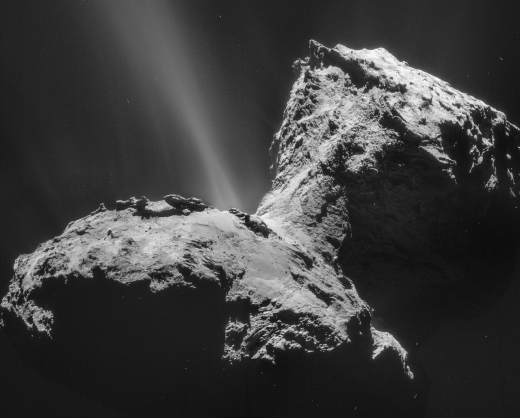
Above: Comet 67P/Churyumov-Gerasimenko photographed by ESA's Rosetta spacecraft
The European Space Agency's Rosetta spacecraft observed the weird lights while it was orbiting Comet 67P in 2014-2016. At first researchers misunderstood what the glow was. It couldn't be auroras, could it? For one thing, the comet doesn't even have a magnetic field--a key ingredient of geomagnetic storms. Also, the lights of Comet 67P are invisible to the human eye. They shine primarily at far ultraviolet wavelengths, unlike the familiar red and green curtains that dance around Earth's poles.
"Nevertheless, they are auroras," says Marina Galand of Imperial College London, UK, lead author of the new study.
It took years for Galand and colleagues to figure out what was going on. Solving the mystery required data from five of Rosetta's sensors plus a physics model to calculate how the solar wind interacts with the comet's atmosphere.
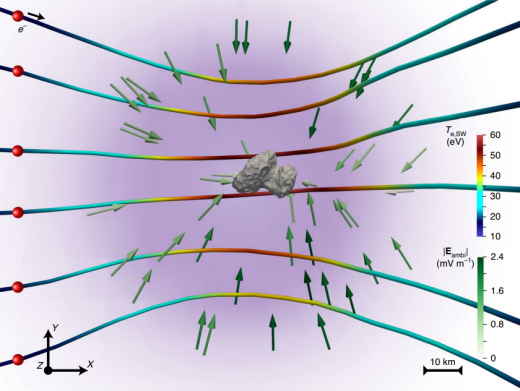
Above: Electric fields in the comet's atmosphere. Credit: J. Deca, Nature Astronomy
They found that electric fields naturally occurring in the comet's atmosphere can grab electrons from the solar wind and hurl them inward. Those electrons rush headlong into water molecules spewing out of the comet's core. Debris from the collision--excited atoms of H and O--produce an ultraviolet glow: Aurora Cometalis.
Comet auroras respond to space weather much like Earth auroras do. Gusts of solar wind can rev them up, and a good coronal mass ejection (CME) can cause an outright auroral storm. Indeed, a CME that hit Comet 67P on Oct. 22, 2014, caused "a sharp intensification" of the UV brightness.
Galand says that "other comets should have these kind of auroras, too." The basic physics is universal. 67P/Churyumov-Gerasimenko's auroras are special only in the sense that the Rosetta spacecraft was there to observe them.
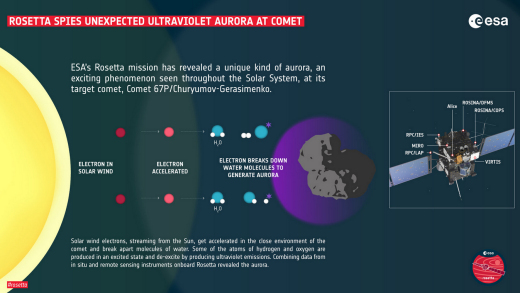
Thought experiment: Suppose you could see UV light. What would the auroras of 67P look like from the comet's surface?
"They would be diffuse, but not uniform," speculates Galand. "Some parts of the sky would be brighter than others--especially if a jet of water crossed your field of view!"
And here's the strangest part of all: The auroras would descend all the way down to the ground. "So you would be surrounded by the light," she says.
Yet another reason to visit a comet...
Realtime Space Weather Photo Gallery
Free: Spaceweather.com Newsletter
A BLACK PEARL IN THE STRATOSPHERE: It came from Tahiti--and now it's been to the edge of space. On Feb. 27, 2020, this genuine Black Tahitian South Sea Cultured Pearl flew to the stratosphere onboard an Earth to Sky Calculus cosmic ray balloon, soaring more than 100,000 feet above the Sierra Nevada mountains of central California:
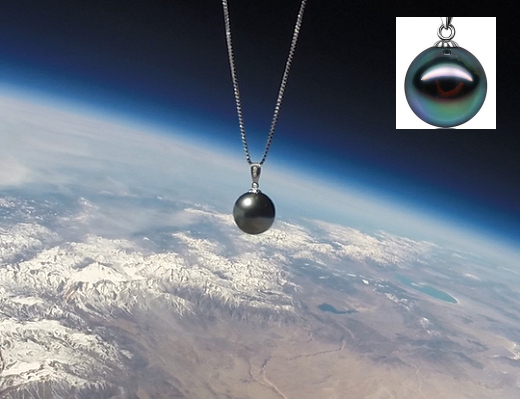
You can have it for $249.95. The students are selling these exotic space pearls to fund their cosmic ray monitoring program. Measuring 10 mm in diameter, the pearl has an 18K white gold clasp and is suspended from a matching 925 Sterling Silver chain. Each pearl comes with a greeting card showing the pendant in flight and telling the story of its journey to the edge of space.
Far Out Gifts: Earth to Sky Store
All sales support hands-on STEM education
Realtime Aurora Photo Gallery
Free: Spaceweather.com Newsletter
Realtime Mars Photo Gallery
Free: Spaceweather.com Newsletter
Every night, a network of
NASA all-sky cameras scans the skies above the United States for meteoritic fireballs. Automated software maintained by NASA's Meteoroid Environment Office calculates their orbits, velocity, penetration depth in Earth's atmosphere and many other characteristics. Daily results are presented here on Spaceweather.com.
On Sept. 22, 2020, the network reported 29 fireballs.
(29 sporadics)
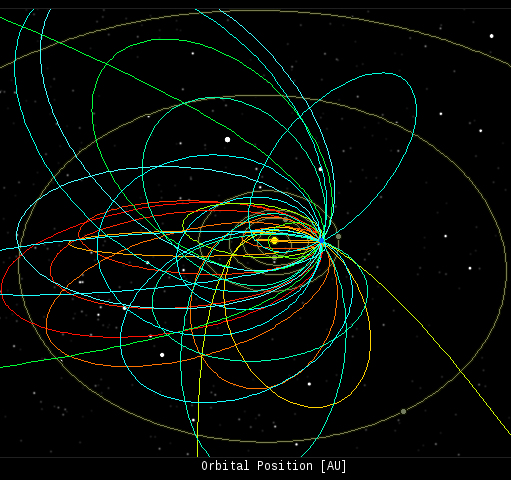
In this diagram of the inner solar system, all of the fireball orbits intersect at a single point--Earth. The orbits are color-coded by velocity, from slow (red) to fast (blue). [Larger image] [movies]
Potentially Hazardous Asteroids (
PHAs) are space rocks larger than approximately 100m that can come closer to Earth than 0.05 AU. None of the known PHAs is on a collision course with our planet, although astronomers are finding
new ones all the time.
On September 22, 2020 there were 2037 potentially hazardous asteroids.
 |
Recent & Upcoming Earth-asteroid encounters: | Asteroid | Date(UT) | Miss Distance | Velocity (km/s) | Diameter (m) |
| 2020 RN1 | 2020-Sep-17 | 18.5 LD | 9.8 | 32 |
| 2020 RZ6 | 2020-Sep-17 | 0.9 LD | 8.7 | 17 |
| 2014 QJ33 | 2020-Sep-17 | 6.7 LD | 8.7 | 65 |
| 2020 RA6 | 2020-Sep-18 | 1.4 LD | 17.4 | 23 |
| 2020 SA2 | 2020-Sep-18 | 1.5 LD | 15.8 | 9 |
| 2020 RC7 | 2020-Sep-18 | 15.6 LD | 8.4 | 24 |
| 2020 RB7 | 2020-Sep-18 | 1.4 LD | 19 | 12 |
| 2020 SR2 | 2020-Sep-18 | 7.5 LD | 7 | 16 |
| 2020 SZ2 | 2020-Sep-19 | 1 LD | 11 | 5 |
| 2020 RH6 | 2020-Sep-19 | 12.4 LD | 8.3 | 37 |
| 2020 SA3 | 2020-Sep-19 | 9 LD | 6.5 | 30 |
| 2020 RQ3 | 2020-Sep-19 | 6.2 LD | 25.4 | 32 |
| 2017 SL16 | 2020-Sep-20 | 8.9 LD | 6.4 | 25 |
| 2020 RP6 | 2020-Sep-20 | 19.1 LD | 7.9 | 38 |
| 2020 RY7 | 2020-Sep-20 | 2.6 LD | 20.6 | 17 |
| 2020 RQ6 | 2020-Sep-21 | 3.4 LD | 6.5 | 11 |
| 2020 SJ2 | 2020-Sep-21 | 3.8 LD | 9.5 | 16 |
| 2020 RD5 | 2020-Sep-22 | 10.6 LD | 17.2 | 55 |
| 2020 SM2 | 2020-Sep-22 | 3.1 LD | 4.5 | 7 |
| 2020 RB6 | 2020-Sep-22 | 6.7 LD | 19.8 | 29 |
| 2020 RU7 | 2020-Sep-22 | 15.3 LD | 6.3 | 30 |
| 2020 RE8 | 2020-Sep-23 | 18.1 LD | 10.7 | 30 |
| 2020 RA2 | 2020-Sep-23 | 18.4 LD | 5.4 | 22 |
| 2020 SN | 2020-Sep-24 | 8.9 LD | 6.9 | 40 |
| 2020 SW | 2020-Sep-24 | 0.1 LD | 7.7 | 6 |
| 2020 RO | 2020-Sep-25 | 15.3 LD | 11.8 | 78 |
| 2020 SM | 2020-Sep-25 | 15.6 LD | 18.4 | 59 |
| 2020 RF4 | 2020-Sep-26 | 11.7 LD | 13.8 | 42 |
| 2020 RF5 | 2020-Sep-27 | 14.1 LD | 3.9 | 53 |
| 2020 PM7 | 2020-Sep-29 | 7.5 LD | 8.3 | 122 |
| 2020 SQ | 2020-Sep-30 | 5.7 LD | 5.9 | 11 |
| 2020 SO2 | 2020-Sep-30 | 18.1 LD | 14.8 | 39 |
| 2020 RJ3 | 2020-Oct-01 | 15.3 LD | 15.5 | 67 |
| 2001 GP2 | 2020-Oct-01 | 6.1 LD | 2.2 | 15 |
| 2020 RZ3 | 2020-Oct-02 | 15.7 LD | 13.3 | 35 |
| 2010 UC | 2020-Oct-04 | 14.6 LD | 3.2 | 12 |
| 2020 RV2 | 2020-Oct-05 | 14.9 LD | 4.2 | 26 |
| 2020 RR2 | 2020-Oct-06 | 16.3 LD | 4.1 | 29 |
| 2020 RK2 | 2020-Oct-07 | 10 LD | 6.7 | 49 |
| 2019 SB6 | 2020-Oct-07 | 11.9 LD | 7.6 | 16 |
| 2020 RO1 | 2020-Oct-09 | 17.4 LD | 3.2 | 29 |
| 2018 GD2 | 2020-Oct-13 | 16.4 LD | 6.7 | 5 |
| 2020 RM6 | 2020-Oct-15 | 13 LD | 7.7 | 39 |
| 2017 UH5 | 2020-Oct-20 | 8.9 LD | 5.9 | 18 |
| 2020 SG3 | 2020-Oct-20 | 19.5 LD | 5.3 | 33 |
| 2018 VG | 2020-Oct-21 | 15.1 LD | 6.7 | 12 |
| 2017 TK6 | 2020-Oct-24 | 17.3 LD | 12.4 | 41 |
| 2008 GM2 | 2020-Oct-25 | 17.7 LD | 3.6 | 8 |
| 2020 QD5 | 2020-Oct-26 | 10.1 LD | 8.6 | 80 |
| 2020 OK5 | 2020-Oct-29 | 6.4 LD | 1.3 | 27 |
| 2018 VP1 | 2020-Nov-02 | 1.1 LD | 9.7 | 2 |
| 2020 HF4 | 2020-Nov-03 | 16.2 LD | 2.9 | 11 |
| 2010 JL88 | 2020-Nov-05 | 10.5 LD | 15.7 | 16 |
| 2019 XS | 2020-Nov-07 | 15.4 LD | 9.4 | 51 |
| 2018 VS4 | 2020-Nov-09 | 14.9 LD | 10.1 | 25 |
| 2020 ST1 | 2020-Nov-14 | 19.1 LD | 8.1 | 164 |
| 2019 VL5 | 2020-Nov-15 | 8.5 LD | 8.2 | 23 |
Notes: LD means "Lunar Distance." 1 LD = 384,401 km, the distance between Earth and the Moon. 1 LD also equals 0.00256 AU. MAG is the visual magnitude of the asteroid on the date of closest approach. | | Cosmic Rays in the Atmosphere |
SOMETHING NEW! We have developed a new predictive model of aviation radiation. It's called E-RAD--short for Empirical RADiation model. We are constantly flying radiation sensors onboard airplanes over the US and and around the world, so far collecting more than 22,000 gps-tagged radiation measurements. Using this unique dataset, we can predict the dosage on any flight over the USA with an error no worse than 15%.
E-RAD lets us do something new: Every day we monitor approximately 1400 flights criss-crossing the 10 busiest routes in the continental USA. Typically, this includes more than 80,000 passengers per day. E-RAD calculates the radiation exposure for every single flight.
The Hot Flights Table is a daily summary of these calculations. It shows the 5 charter flights with the highest dose rates; the 5 commercial flights with the highest dose rates; 5 commercial flights with near-average dose rates; and the 5 commercial flights with the lowest dose rates. Passengers typically experience dose rates that are 20 to 70 times higher than natural radiation at sea level.
To measure radiation on airplanes, we use the same sensors we fly to the stratosphere onboard Earth to Sky Calculus cosmic ray balloons: neutron bubble chambers and X-ray/gamma-ray Geiger tubes sensitive to energies between 10 keV and 20 MeV. These energies span the range of medical X-ray machines and airport security scanners.
Column definitions: (1) The flight number; (2) The maximum dose rate during the flight, expressed in units of natural radiation at sea level; (3) The maximum altitude of the plane in feet above sea level; (4) Departure city; (5) Arrival city; (6) Duration of the flight.
SPACE WEATHER BALLOON DATA: Approximately once a week, Spaceweather.com and the students of Earth to Sky Calculus fly space weather balloons to the stratosphere over California. These balloons are equipped with radiation sensors that detect cosmic rays, a surprisingly "down to Earth" form of space weather. Cosmic rays can seed clouds, trigger lightning, and penetrate commercial airplanes. Furthermore, there are studies ( #1, #2, #3, #4) linking cosmic rays with cardiac arrhythmias and sudden cardiac death in the general population. Our latest measurements show that cosmic rays are intensifying, with an increase of more than 18% since 2015:

The data points in the graph above correspond to the peak of the Regener-Pfotzer maximum, which lies about 67,000 feet above central California. When cosmic rays crash into Earth's atmosphere, they produce a spray of secondary particles that is most intense at the entrance to the stratosphere. Physicists Eric Reneger and Georg Pfotzer discovered the maximum using balloons in the 1930s and it is what we are measuring today.
En route to the stratosphere, our sensors also pass through aviation altitudes:

In this plot, dose rates are expessed as multiples of sea level. For instance, we see that boarding a plane that flies at 25,000 feet exposes passengers to dose rates ~10x higher than sea level. At 40,000 feet, the multiplier is closer to 50x.
The radiation sensors onboard our helium balloons detect X-rays and gamma-rays in the energy range 10 keV to 20 MeV. These energies span the range of medical X-ray machines and airport security scanners.
Why are cosmic rays intensifying? The main reason is the sun. Solar storm clouds such as coronal mass ejections (CMEs) sweep aside cosmic rays when they pass by Earth. During Solar Maximum, CMEs are abundant and cosmic rays are held at bay. Now, however, the solar cycle is swinging toward Solar Minimum, allowing cosmic rays to return. Another reason could be the weakening of Earth's magnetic field, which helps protect us from deep-space radiation.
| | The official U.S. government space weather bureau |
| | The first place to look for information about sundogs, pillars, rainbows and related phenomena. |
| | Researchers call it a "Hubble for the sun." SDO is the most advanced solar observatory ever. |
| | 3D views of the sun from NASA's Solar and Terrestrial Relations Observatory |
| | Realtime and archival images of the Sun from SOHO. |
| | from the NOAA Space Environment Center |
| | fun to read, but should be taken with a grain of salt! Forecasts looking ahead more than a few days are often wrong. |
| | from the NOAA Space Environment Center |
| | the underlying science of space weather |
 | To find reviews of new online casino sites in the UK try The Casino DB where there are hundreds of online casino reviews complete with bonuses and ratings. Get a bonus when playing at a new casino in the UK. The Genie got you covered! Looking for a new online casino? Try Casimpo the new site dedicated to making online casino simple, or check out the new Avenger Slots Casino and Slot Strike Casino Sites with over 500 online slots and casino games. . |
| | These links help Spaceweather.com stay online. Thank you to our supporters! |
| | | | | | |

